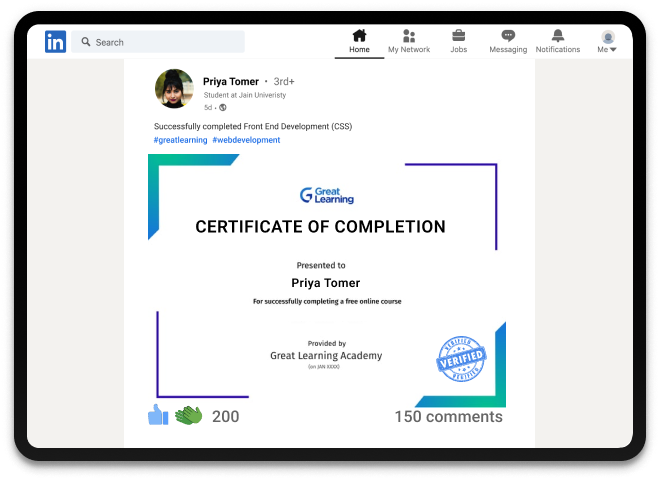Introduction to Cloud and Airflow
Gain knowledge of Cloud and Airflow from basics to advance through this free introduction to cloud and Airflow course. Get experience creating the workflow, Airflow instances, and DAG through hands-on demos.
What you learn in Introduction to Cloud and Airflow ?
About this Free Certificate Course
This introduction to Cloud and Airflow free course focuses on enhancing your knowledge of cloud services. The course starts by briefing you about Cloud and Airflow. It will focus on Airflow architecture and comprehend the components involved along with their roles. Next, you will go through Airflow operators and understand the various functions and capabilities it enables.
Further, you will have a better hands-on understanding of creating workflow and Airflow instances, along with an understanding of how to push a DAG into production. This free course also focuses on Airflow UI and helps you understand interacting with DAG through a hands-on demo. Complete these modules to earn a free certificate of course completion.
Learn advanced cloud computing concepts through Great Learning's Best Cloud Computing Courses. Gain a course completion certificate after completing the program and grab better job opportunities.
Course Outline
This module covers various cloud services, cloud service providers, business and technical decisions regarding which cloud service to choose on which service provider. You will also understand the need for cloud services for organizations.
This module provides an intro to Airflow and an understanding of how it is structured. You will also go through many of the tools involved and comprehend other crucial concepts.
This module helps you comprehend the overall application architecture of Airflow. You will understand the components involved and their role in this cycle.
This module focuses on Airflow operators and understanding the functions and capabilities Airflow enables customers to use and make decisions.
This module gives you an example of creating a workflow using Python. You will go through an example of DAG and understand its components.
With this course, you get
Free lifetime access
Learn anytime, anywhere
Completion Certificate
Stand out to your professional network
1.5 Hours
of self-paced video lectures
Frequently Asked Questions
What prerequisites are required to learn this introduction to Cloud and Airflow course?
Enrolling in this free introduction to cloud and Airflow course requires no prerequisites, and it is mainly designed for beginners to learn it from scratch.
How long does it take to complete this free introduction to Cloud and Airflow course?
This free introduction to Cloud and Airflow course contains 1.5 hours of self-paced videos that learners can take up according to their convenience.
Will I have lifetime access to this free online course?
Yes. You will have lifetime access to this free online introduction to Cloud and Airflow course.
What are my next learning options after this cloud and Airflow course?
You can enroll in Great Learning's Cloud Computing Program by the University of Texas at Austin's McCombs School of Business to gain advanced and crucial cloud computing skills and earn a certificate of course completion.
Is it worth learning about Cloud and Airflow?
Yes, it is worth learning about clouds and Airflow. Cloud computing is an essential technology for businesses of all sizes, and Airflow is an open-source platform that allows cloud users to automate, schedule, and monitor data processing pipelines. These technologies provide organizations with an efficient way to manage their data and operations. Learning about Cloud and Airflow can help businesses to become more efficient and reduce costs.
Success stories
Can Great Learning Academy courses help your career? Our learners tell us how.And thousands more such success stories..
Related Cloud Computing Courses
Popular Upskilling Programs
Explore new and trending free online courses
Relevant Career Paths >
Introduction to Cloud and Airflow
In the ever-evolving landscape of technology, cloud computing and Apache Airflow have emerged as two essential pillars driving innovation and efficiency across various industries. These technologies have transformed the way organizations manage their data, processes, and applications, enabling them to scale and adapt to changing demands with unprecedented agility.
Cloud Computing: The Backbone of Modern IT
Cloud computing is a paradigm that delivers computing services, including storage, databases, networking, analytics, machine learning, and more, over the internet. Instead of maintaining and managing on-premises hardware and software, organizations can leverage the vast infrastructure of cloud providers like Amazon Web Services (AWS), Microsoft Azure, and Google Cloud Platform (GCP) to access resources on a pay-as-you-go basis.
One of the most significant advantages of cloud computing is scalability. Organizations can instantly increase or decrease their computing resources based on demand, eliminating the need for over-provisioning and reducing operational costs. Moreover, cloud providers offer a range of managed services, simplifying tasks like database administration, security, and data analytics. This allows businesses to focus on innovation and application development rather than infrastructure management.
Security and compliance are also paramount in the cloud. Cloud providers invest heavily in robust security measures, ensuring data encryption, identity and access management, and compliance with industry standards and regulations. This alleviates many of the security concerns that come with traditional on-premises infrastructure.
Cloud computing has further democratized access to cutting-edge technologies like artificial intelligence, machine learning, and big data analytics. Organizations of all sizes can harness the power of these technologies without the need for significant upfront investments in hardware and software.
Apache Airflow: Orchestrating Workflows with Precision
Apache Airflow, an open-source workflow automation tool, plays a pivotal role in modern data engineering and analytics. It allows organizations to create, schedule, and monitor workflows, making it easier to manage complex data pipelines, ETL (Extract, Transform, Load) processes, and batch or real-time data processing tasks.
At its core, Airflow uses Directed Acyclic Graphs (DAGs) to represent workflows. Users define the tasks and their dependencies, creating a clear and structured workflow. Airflow's scheduler then ensures that tasks run in the specified order and handles retries and failures gracefully.
One of Airflow's strengths is its extensibility and flexibility. Users can customize it to meet their specific requirements by creating custom operators, sensors, and executors. It also supports a wide range of integrations with popular data tools and services, allowing seamless interaction with databases, message brokers, cloud platforms, and more.
Visibility and monitoring are crucial aspects of workflow management. Airflow provides a user-friendly web interface where users can visualize DAGs, track task execution, and set up alerts for failures or delays. This transparency enables quick identification and resolution of issues, improving the reliability of data workflows.
The Synergy of Cloud Computing and Apache Airflow
The combination of cloud computing and Apache Airflow is a potent force for organizations looking to streamline their data operations. Cloud services provide the scalable and reliable infrastructure needed to support Airflow's workflow orchestration, making it an ideal companion for cloud-native applications.
By deploying Airflow in the cloud, organizations can leverage the scalability and cost-effectiveness of cloud resources while benefiting from Airflow's workflow automation capabilities. This synergy allows for dynamic scaling of resources as workflows demand, ensuring optimal performance and cost efficiency.
Furthermore, cloud-native integrations simplify the setup and management of Airflow instances. Cloud providers offer managed services that handle infrastructure provisioning and scaling, making it easier to focus on configuring and fine-tuning Airflow for specific use cases.
In conclusion, cloud computing and Apache Airflow are integral components of the modern technology stack, enabling organizations to innovate, scale, and manage data operations effectively. Cloud computing provides the infrastructure and tools needed to support dynamic workloads, while Airflow empowers organizations to automate and orchestrate complex data workflows with precision. Together, they form a powerful combination that drives efficiency and agility in the ever-evolving world of technology. As businesses continue to embrace digital transformation, the synergy between cloud computing and Apache Airflow will play an increasingly pivotal role in their success.



















































